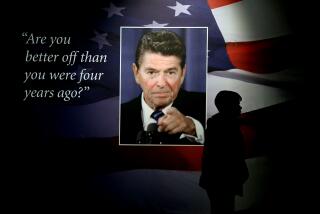Jury Is Still Out on Reaganomics
- Share via
Reading about and watching President Reagan’s visit to Moscow powerfully suggest that things have changed in the geopolitical sphere since the beginning of this Administration. It prompted me to do a little retrospective on other aspects of the Reagan presidency, particularly Reaganomics.
While the domestic economy has not changed as dramatically as U.S.-Soviet relations, there have been some big changes both for better and for worse. The table is a brief report card on Reaganomics compared to other administrations in the 1960s and ‘70s.
To his credit, President Reagan can claim success on several fronts, most notably lower unemployment, inflation and interest rates as well as higher productivity and stock prices. As indicated in the table, consumer price inflation was accelerating throughout the late ‘60s and ‘70s but peaked soon after the Reagan Administration took office. The fever in spot industrial commodity prices (excluding oil) was dramatically broken during the early Reagan years. The underlying rate of consumer inflation (excluding food and energy) has stayed within an exceedingly narrow range of roughly 3.5% to 5% for the past five-plus years.
The continuous, decades-long rise in interest rates was also broken during the Reagan Administration. While rates have moved up somewhat in recent months, they are much lower, at least in nominal terms, than the stratospheric levels reached just after the Reagan Administration took office. As the table indicates, for the first time in 30 years, an Administration is likely to leave office with nominal interest rates lower than those they inherited. If we look at interest rates in real terms (after deducting inflation), the picture isn’t that good, but I think the Administration does deserve credit for breaking the trend.
Of course, one might quibble here about cause and effect, such as whether the current low inflation and interest rates are more the legacy of monetary actions started late in the Carter Administration than a result of Reaganomics. For that matter, it may have been old-fashioned tight money carried on for a longer period than usual that turned the tide, rather than anything in the Reaganomics kit bag. But cause and effect are hard to pin down, and, if I were the President, I’d take credit for it.
Even if we look at that traditional icon of Democratic stewardship, the unemployment rate, a long-lasting trend appears to have been broken. After the unemployment rate had crept upward with every business cycle since 1960, the Reagan Administration will leave office with the rate sharply below the 7% to 8% level where it had been left by the two previous Administrations.
Now, some economists will argue that the quality and pay of many of those new jobs are subpar and, to be sure, that’s arguable. Others will add that the Reagan Administration was the accidental beneficiary of a significant slowdown in the growth of the labor force--the number of people looking for work. (The Baby Boomers had been pretty well absorbed into the labor force by the early ‘80s.)
Accordingly, Reaganomics was able to lower the unemployment rate even though growth in the number of people employed was below the norm for previous administrations. Nevertheless, it would be hard to deny that the Reagan Administration has left job market conditions in better shape than in years.
That’s the good news.
The bad news is that Reaganomics will have left several new and dangerous trends in its wake, trends that may yet undo most of the favorable legacy. First, contrary to the early ballyhoo about supply-side economics, what happened to all that deferred gratification--saving--that was supposed to gush forth once tax rates were sufficiently reduced? During the ‘60s and ‘70s, the personal saving rate typically was at 7%. Virtually at the outset of Reaganomics, it began to drop and is at a postwar record low of 4% to 4.5%.
Spending Binge
Part of the answer to the saving mystery may lie in the surprising fact that, despite the Administration’s concerted efforts to reduce income tax rates, it will leave office with total personal taxes relative to income at a higher level than any of its predecessors. This measure includes Social Security taxes, which have risen sharply in recent years. To its credit, however, without the Reagan Administration’s constant pushing, the burden probably would be a lot heavier than it is.
The flip side of reduced saving has been a consumer spending binge. In this last year of Reaganomics, consumer spending relative to gross national product will be the highest since World War II. And that spending has been supported not only by reduced saving but by very large accumulations of consumer debt as well.
The federal government has been on the same sort of debt-supported spending binge. During the term of an Administration that prided itself on opposing government spending, federal outlays grew faster than in any other postwar Administration except during the Vietnam building of the Kennedy-Johnson years. Spending grew much faster than revenues, diminished as they were by income tax reduction as well as by tax indexing. In fairness, however, the blame for excess spending belongs as much with Congress as it does with the Administration. Actually, the blame belongs with us, the American people, because we want to have our cake and eat it too.
As a result, the federal budget deficit--government “dissaving”--appears stuck at about 4% of GNP, if we adjust for where we are in the business cycle. That is a high level by any historical standard. In plain fact, no one inside the United States is doing much to provide the financing needed for future economic growth. At the same time, the ratio of debt to GNP in this country has reached levels not seen since the early ‘30s. But, for the moment, we’re still growing; indeed, we’re well into an unprecedented sixth year of unbroken economic expansion. Where’s the financing coming from?
That brings me to the final and potentially most dangerous negative legacy of Reaganomics: the burgeoning U.S. trade and current account deficits and the weak dollar. The heavy net inflow of capital from abroad that we require to finance our domestic economy has, as its counterpart, a burgeoning trade deficit. At 2.6% of GNP, the trade deficit in the closing year of Reaganomics is a record by any measure and continues a disturbing trend of several years.
I am forced to conclude that, while Reaganomics has been good for America in many ways, the book requires a final--as yet unwritten--chapter for it to be fairly judged. It is hard to escape the feeling that too much of what were admittedly good times was improperly financed with borrowed money. In the final chapter, written in the next Administration, somebody is going to be forced to start balancing the accounts--the hard way! Only then can we pass final judgment on Reaganomics.
REAGANOMICS VS. OTHER ADMINISTRATIONS Percentages show compound annual rate of change, except where noted.
Kennedy-Johnson Nixon-Ford Carter Economic Indicator 1960-68 1968-76 1976-80 CPI inflation 2.1% 7.2% 9.0% Spot industrial prices** -0.5 9.5 10.4 U.S. Treasury bond yields*** 5.26 6.78 10.81 S&P; 500 stock prices 7.4 0.4 3.9 U.S. dollar, trade weighted 0.0 -1.8 -4.6 Unemployment rate*** 3.6 7.7 7.1 Disposabel income (real) 2.1 2.2 1.5 Civilian labor force 1.7 2.5 2.7 Non-agricultural employment 2.9 2.0 3.3 Productivity (nonfarm) 2.9 1.2 0.8 Personal saving rate*** 7.0 7.6 7.1 Individual federal tax burden*** 16.8 17.4 18.9 Consumption/GNP*** 61.9 63.4 63.4 Federal deficit/GNP*** 0.7 3.0 2.2 Merchandise trade deficit/GNP*** 0.0 0.4 0.8
Reagan Economic Indicator 1980-88* CPI inflation 3.9% Spot industrial prices** 0.1 U.S. Treasury bond yields*** 9.30 S&P; 500 stock prices 9.9 U.S. dollar, trade weighted 0.0 Unemployment rate*** 5.4 Disposabel income (real) 1.8 Civilian labor force 1.6 Non-agricultural employment 1.9 Productivity (nonfarm) 1.3 Personal saving rate*** 4.3 Individual federal tax burden*** 19.5 Consumption/GNP*** 66.5 Federal deficit/GNP*** 3.2 Merchandise trade deficit/GNP*** 2.6
*Estimate. **Excludes oil. ***Level in final year, not rate of change.
Los Angeles Times
More to Read
Get the L.A. Times Politics newsletter
Deeply reported insights into legislation, politics and policy from Sacramento, Washington and beyond. In your inbox twice per week.
You may occasionally receive promotional content from the Los Angeles Times.









